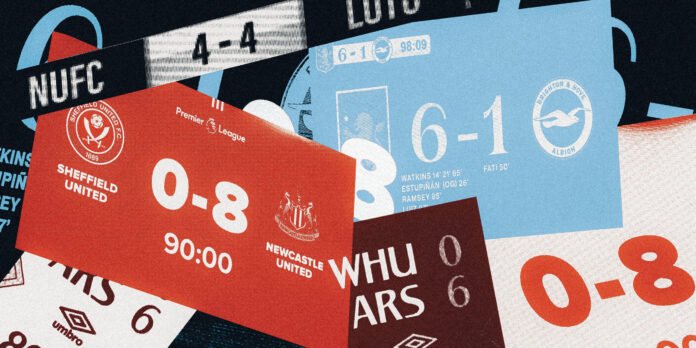Boxing Day, 1963. English football shorthand for the sort of entertainment you just don’t get anymore. Or so we thought.
On that day, 66 goals were scored across 10 games in the English top flight. Chelsea beat Blackpool 5-1, Fulham scored 10 times against Ipswich Town and West Ham United conceded eight against Blackburn Rovers.
But that Christmas goal fest wasn’t a particularly odd day for that season. There were 19 occasions of a team scoring six or more goals in a game, and the 1963-64 season averaged 3.4 goals per game, a rate that hasn’t been achieved since.
But this Premier League season is edging ever closer to that magical figure. High-scoring games such as Manchester City’s 4-4 draw away to Chelsea, Luton Town’s identical result against Newcastle United and the latter’s 8-0 victory against Sheffield United comes to mind.
It’s not only about these results, though. The constant flow of goals in every game has meant that, in 250 Premier League games this season, there have only been eight goalless draws. That leaves us with an average of 3.23 goals per game this season — the highest rate in England’s top flight since 1964-65, which saw 3.34 goals per game.
For the majority of the Premier League’s audience, more goals equals more entertainment, but it’s not a proportional relationship.
An increase in the number of goals could be due to multiple thrashings occurring because of the gap between some teams and the rest of the league. Another reason behind a high goals-per-game ratio could be the lack of any defensive organisation — and few people watching football want to see a basketball game. Besides, for some, there is a certain pleasure in tactical 0-0s and narrow victories.
So goals per game are up this season, but why?
Firstly, a focus on timewasting from the game’s authorities around ball-in-play time has seen an increase in added time in the Premier League this season. On average, each game has 11 minutes and 42 seconds of added time this season compared to an average of six minutes and 54 seconds in the last 10 seasons. The average added time in the second half alone this season (seven minutes and 29 seconds) is greater than the overall average added time in the last 10 seasons. Let that sink in.
More playing time increases the probability of goals, especially with teams throwing everything at opponents towards the end of the games and tired legs coming into play. But that can’t be the only reason for that jump in the rate of goals per game.
Ange Postecoglou’s Spurs have scored in every Premier League game they’ve played this season (Visionhaus/Getty Images)
The playing style of multiple teams outside the ‘Big Six’ has evolved towards a more proactive approach. You could even include Tottenham Hotspur among those teams. The arrival of Ange Postecoglou has seen Spurs play a more expansive type of football that has seen them reach a goalscoring run of 37 consecutive Premier League games — the second-longest run of scoring in consecutive Premier League games any team has put together.
In divisions containing 20 or more clubs, only one top-flight team — Arsenal in 2001-02 — has scored in every league game in a single campaign. Postecoglou’s Spurs are 13 games away from emulating their rivals.
“We just want to score more goals than everyone else,” Postecoglou told Hudl’s High Performance Insights in 2020. “Winning 4-3 is more exciting than winning 1-0.”
Brighton’s move towards being a proactive team under Graham Potter has been followed by significantly more goals under Roberto De Zerbi, Villa’s fortune has turned under Unai Emery, who is leading them in the battle for Champions League qualification, while Newcastle are trying to maintain the successes of last season under Eddie Howe.
All of these sides have transitioned to teams that are looking to dominate the game — on and off the ball — regardless of the opponent.
At the other end of the table, Luton Town, Burnley and Sheffield United are conceding goals at an unprecedented rate in the Premier League for teams occupying the bottom three positions. On average, they have conceded 2.3 goals per game — the highest rate in Premier League history for teams in the relegation zone.
Sheffield United have been conceding goals at a rate of 2.6 per game this season — more than any side in Premier League history, even more than Swindon Town’s century of goals conceded in 1993-94 (2.4 but across 42 games) and Derby County’s notorious 11-point season in 2007-08 (2.3).
Despite Luton’s successful attempts at being proactive in certain situations and thriving on set pieces, it’s fair to say that there is a gap in player quality between the bottom three teams in the Premier League this season and the rest of the league.
The intensity of Rob Edwards’ side fits a certain trend in the Premier League in the last couple of seasons: more teams are willing to press up the pitch and try winning the ball there. “It’s risky but it’s also entertaining and it gives us a better chance of winning. We want to entertain. We want to try to be good to watch,” Edwards recently told The Athletic. “It suits us as a football club as well. Yes, there’s a risk, but the reward is greater than the risk.”
If you hear other Premier League managers talking about the risk and reward of pressing, then don’t be surprised. Most teams in the Premier League want to win the ball higher up the pitch, whether that is in the form of pressing the opponent’s build-up or counter-pressing shortly after losing the ball.
Since 2018-19, the average amount of possession regains in the attacking third in a Premier League match has risen by 37 per cent — from 7.6 to 10.4 this season.
This increase has consequentially seen more goals scored from winning the ball in the final third. The average number of goals scored per game from possession regains in the attacking third this season (0.30) is more than twice the rate of 2018-19 (0.13). Quite simply, more goals are coming from transitional situations high up the pitch due to the Premier League’s focus on pressing and counter-pressing.
Even counter-attacks that start from deeper positions have been on the rise, which is notable in the direct attack numbers. These are defined as possessions that start in a team’s own half and result in either a shot or a touch inside the opposition penalty area within 15 seconds.
The rate of 5.4 direct attacks per game in the Premier League this season is the highest since 2019-20.
The transitional nature of the Premier League this season is one of the reasons why the goal rate has increased. Contrary to controlled matches, a game full of transition is unpredictable and leaves more space to attack.
One side that has been riding this wave are Liverpool. Jurgen Klopp’s team have reverted back to an older version of themselves. This Liverpool side thrives on transitions and in a transitional version of the league, it’s not surprising to see them at the top of the table. However, there are other ways to sustain a title push.

(Clive Brunskill/Getty Images)
“We don’t like to play the counter-attack, but we have to use it,” said Manchester City manager Pep Guardiola last December. City and Arsenal — the two teams battling it out with Liverpool for the title — focus more on controlling games than entering transitional duels. But that doesn’t necessarily mean fewer goals. Arsenal have scored 21 goals in their last five league games, while City have scored three or more goals in 11 of their games in 2023-24.
All of this means there are explicable reasons why the Premier League’s leading contenders, the chasing pack and the strugglers are all experiencing games laden with goals this season.
Whether it’s a temporary blip or a genuine return to the scoring rates of the 1960s remains to be seen — but it will be entertaining to find out.
(Header photos: Getty Images)
Read the full article here


